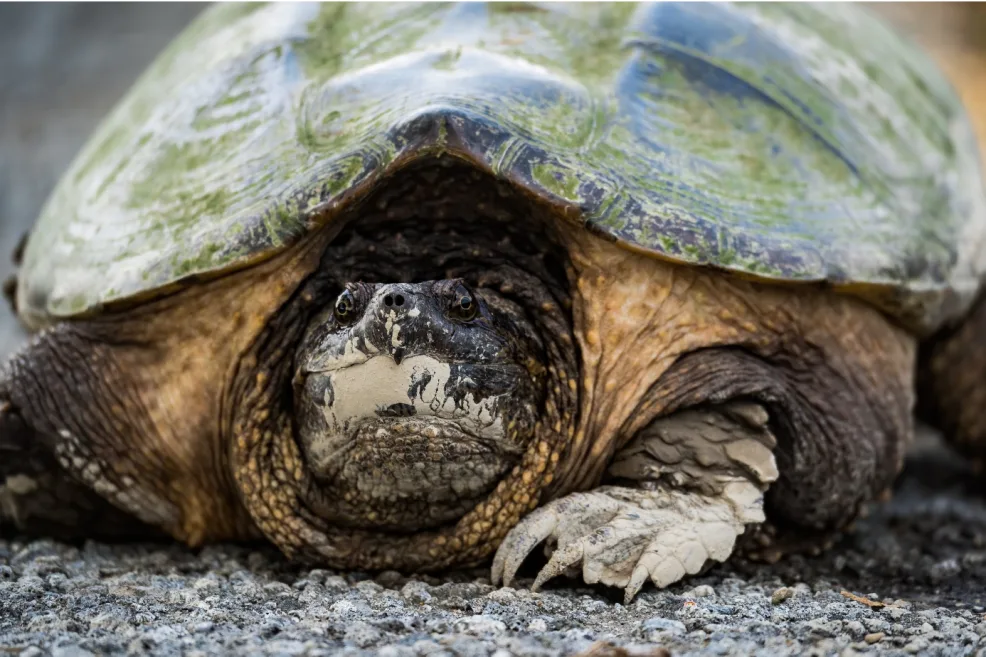
What to do if you spot a turtle on the road
The Weather Network's Mark Robinson speaks with the Ontario Turtle Conservation Centre about what to do if you come across a turtle on the road.
It wasn’t immediately obvious what the large dark shape was, especially as I was driving down the road trying to get to a storm, but given that it was sitting in the middle of the road, it couldn’t be good. A few seconds later, I realized I was looking at a large snapping turtle sitting right on the dotted yellow line in the middle of the highway. I knew that being on a road just south of Bancroft was not ideal for any animal, let alone a large turtle, so I pulled over, ran across the road and dragged the reptile to safety.
Perfect story, right?
Well …, yes, but I’d made one big mistake – I had heard that the best way to pick up a snapping turtle was by the tail so that you wouldn’t get bitten. This is all kinds of wrong and could possibly do serious damage to the turtle as I was informed quickly by many of my Twitter followers.
So, since I’d made that big mistake (the turtle turned out ok BTW), I was determined to figure out how to move a turtle properly and to do that, I needed to find someone who dealt with turtles on a regular basis. That turned out to be an organization in Peterborough known as the Ontario Turtle Conservation Centre. I talked to Dr Sue Carstairs, its Executive and Medical Director who invited me out to teach me how to pick up a turtle properly and teach me a bit about the situation of turtles in Ontario. And, spoiler alert, it’s not good.
I arrived at the small, unassuming building on the edge of the city in the late afternoon on the day that the organization was busy cleaning out habitats and preparing to move out a number of turtle hatchlings to help repopulate Ontario’s depleted turtle numbers. Dr Sue Carstairs told me that the organization is involved in a number of aspects of turtle conservation, including rescue, rehabilitation, breeding programs, research, and education and part of that meant that once in a while a full cleaning of the building was needed. And yes, the accompanying smell was eye watering.

(Snapping turtle. Credit: Tina Nord/Pexels)
RELATED: Here's why experts advise against feeding wildlife
Sue explained that southern Ontario is home to the vast majority of turtles in Canada, but at the same time is also one of the most road intensive areas of the country, “Ninety percent of turtle injuries that are brought in are caused by cars. Southern Ontario is probably the place for turtles in Canada and it’s also home to the largest network of roads, so you can’t go more than a kilometre or two without running into a road. These turtles, although semi-aquatic, do spend a lot of time on land. And they do travel many kilometres on land for a variety of reasons, to find a nesting spot, a mate or where they want to hang out for the summer or winter. So, they’re going to run across a road.”
With 1500 turtles coming in every year, mostly in the warm months, the organization has a tremendous amount of work on their hands ensuring that the turtles are able to get to the Centre for care. To ensure the best, and fastest transportation is available, the organization has over 1000 volunteers scattered throughout Ontario ready to go at a moment’s notice. So, if the snapping turtle I’d come across on the highway had been injured, I could have called the Centre who would then dispatch someone to come and pick up the turtle from me. This makes it extra easy for the general public to help out our threatened turtle species.
Once the turtle arrives at the Centre, there are medical facilities ready to go, including an X-ray machine, and a full surgical bay. That’s when the team gets to work with healing injuries, and rehabilitating their patients. However, it’s the initial encounters out in the wild that are critical to a turtle’s survival.
If the turtle isn’t injured and you come across it on the side (or in) the road, you can still help out. Sue laughs as she explains what to do.
“Turtles haven’t been around for 200 million years by getting lost, they know where they want to go. So, just keep them going in the direction they want to go and you may have saved a turtle life.”
“But,” she stresses, “we don’t want people endangering their own lives to help a turtle, as much as we love them. If you feel it’s safe to do so, pull over and put your flashers on. If you’ve got a reflective vest use that. Please don’t risk your life!”
Sue explains, “Turtles are meant to live a long, long time, and if we lose the adults in the population, there’s no way to replace them so we make sure that we save them so that they can go back into the wild to do what they do. So few make it to adulthood so every one of those is vital to the survival of the population.” Which means, having lots of turtle babies. However, even then, our Ontario turtles are under major threat.
There are eight species of turtles in Ontario, all of which are listed as “Special Concern” to fully “Endangered” thanks to habitat destruction and human activities. They replace their numbers slowly and with difficulty as only a few turtles make it to breeding age, which takes many years.
Finally, Sue took me inside the education area of the centre to let me meet one of their permanent residents, a large snapping turtle that had been severely injured by an encounter with a boat propellor. She pulled him out of his large pond and showed me what I’d done wrong when rescuing the large snapping turtle near Bancroft.
“What you want to do is come up behind them and with your non dominant hand, slide it under the tail and then slide your other hand underneath and along the midline like a tray of drinks and then move them off the road in the direction they were going.”
So, if you spot a large lump on the side of the road that happens to be a turtle, and, if you can stop and help out safely, do so (but don’t make my mistake!). However, if you can’t, there are people to help out at the Ontario Turtle Conservation Centre. Just tell them Mark sent you.
For more information on what to do if you encounter an ‘out of place’ turtle, please watch the video that leads this article.






